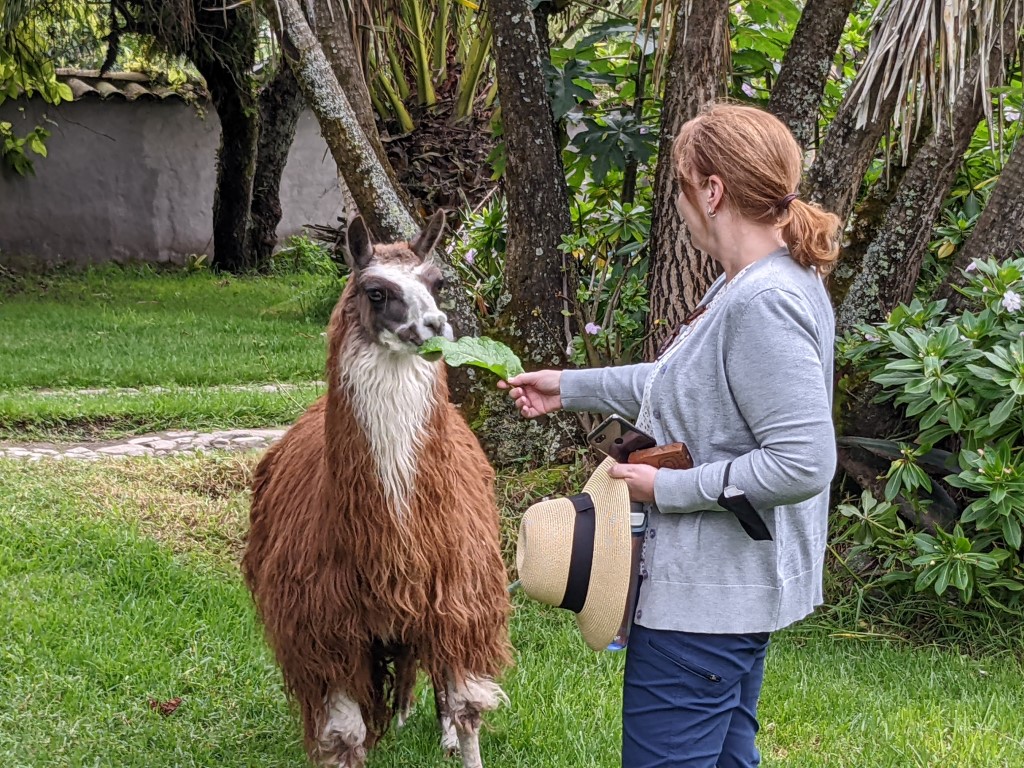Quito
We flew from Medellin, Colombia to Quito, Ecuador with a layover in Bogota. Quito was the very first UNESCO World Heritage City. Founded on an ancient Inca city, and at 9,300 feet elevation in the Andes, it is the highest capital city in the world. The old downtown area is perhaps the least changed from colonial times, which helps explain the narrow streets and nearly non-existent sidewalks in places.
Our hotel was the was a renovated building that was first built in the 16th century and passed through many different uses. The building is a roughly square, two stories with exterior walls roughly 4 feet thick. The rooms around the edge leaving an open central courtyard. A glass roof now encloses the whole courtyard.
This old downtown area has many shops that are open during the day, but after the shops close, the streets are nearly empty, with a lot of police presence. There are apartments above the shops, but few are occupied. Apparently, nobody wants to live in that area. However a school drum team did come past our window at 7 am one morning…

Above: A puffy empanada, women selling fruit on the street. One dollar per bag.
We took a guided walking tour and learned about the history of Quito, tasted local fruits (some we’ve never seen before), learned about Ecuador’s role in the global flower market (roses are a huge export here, famous for their long, straight stems – thanks to the straight up sun at the equator), and learned about herbal healing rituals and the chocolate making process.
Later, we visited the Basilica de Voto Nacional. Impressively large, built at the end of the 19th century, and the largest neo-Gothic church in South America. The basilica has stores and restaurants in the towers. The large Rose window in the basilica has orchids in the details.
We also visited a Jesuit church called Iglesia de la Compañía de Jesús, Started in 1605, it took 160 years to complete. Nearly every interior surface is covered in gold leaf. It has been visited by two popes. The photos don’t do this justice.
Otavalo
We rented a car in Quito and drove to Otavalo. On our way to Otavalo, we stopped at Mitad del Mundo, a tourist attraction directly on the equator where we did some equator games (like balancing an egg on a nail head) and learned some about the indigenous tribes of the region. This included tribes that made shrunken heads of their defeated enemies. See actual shrunken head below.
We stayed two nights at Las Palmeras Inn outside of Otavalo. Side roads are often of questionable repair, and the road got pretty bad before we got to our destination, but the place itself was nice. Each evening a worker came to build a fire in the fireplace in our room, and left hot water bottles to warm our feet in bed. It was cozy sitting by the fireplace in the evening, but the nights were cool in bed. On the second morning my hot water bottle leaked some in the middle of the night, so I had damp cold sheets by morning.



We visited the Otavalo Market, said to be the largest indigenous market in South America. Lots of beautiful handiwork. We bought blankets and other handmade items as gifts. We are now committed to a checked bag on our return trip.
We also visited the nearby Cascada de Peguche, a beautiful waterfall about a 15 minute walk from the parking lot.
On Sunday we attended church at a congregation in Otavalo. Everyone in their best native apparel, men and women with braided pony tails, older women in traditional head coverings. bishopric in ponchos. Awesome. Besides one missionary we were the only gringos in attendance. The clerk even came over during the meeting to ask our names and later the bishop welcomed us by name before the speakers spoke. Everyone there was so friendly.
Zumbahua and Quilotoa Lagoon
From Otavalo, we drove 4 hours down past Quito and up a windy mountain road waaay up in the Andes mountains to Zumbahua, a little town near Quitoloa Lagoon. Oddly, all along the roadside there were dogs just sitting and watching traffic, as if waiting for someone. Sunday afternoon happened to be a little festival in town. The town brass band played some tunes, then a hired band played songs on stage. Some folks were dancing, and seemed amused and accepting when we joined in. In general though, the women talked, the men got drunk and at least one pesky dog was kicked.
We came out here to do a bit of hiking on the rim of the Quilotoa crater, with views of the beautiful Quilotoa lagoon inside the crater. The original plan was to hike all the way around the rim of the Quilotoa Crater. After checking weather, considering the altitude (12,700 feet) and reading more about the hike, we decided to just hike out and back a ways and just admire the changing lighting and clouds on the lagoon. Our little hotel has no heat, but lots and lots of blankets for the 30-40 degree temperatures. Altitude trumps latitude for how cold it is
Next up, Banos and Cotopaxi!
























































Leave a Reply